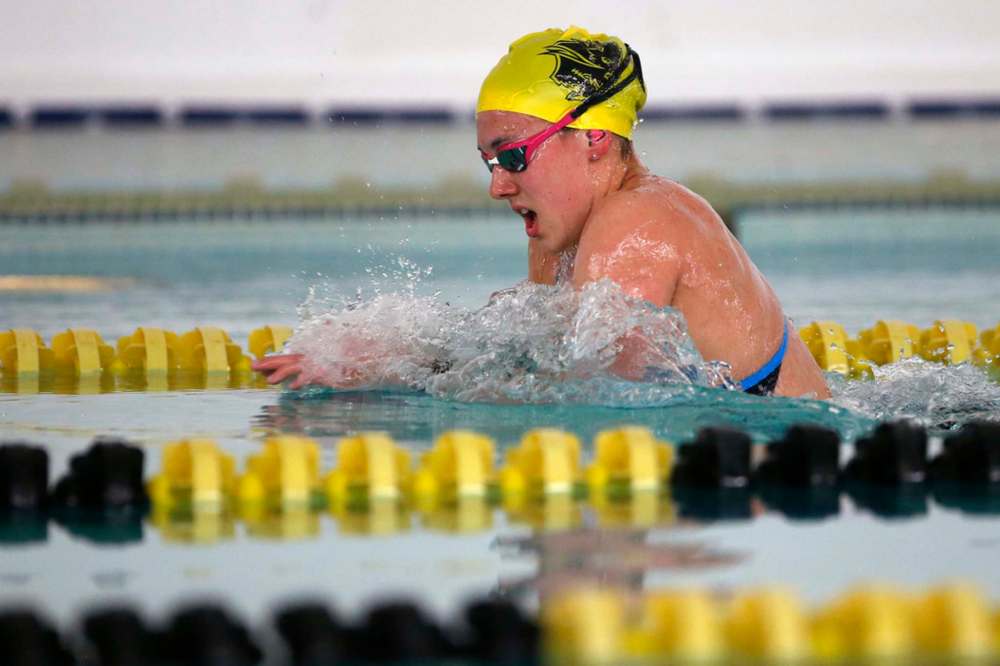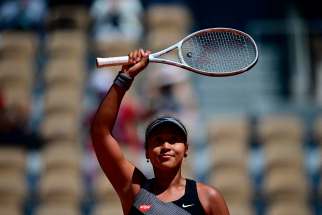Born to swim Winnipeg Olympic hopeful Wog a natural in the pool
Read this article for free:
or
Already have an account? Log in here »
To continue reading, please subscribe:
Monthly Digital Subscription
$0 for the first 4 weeks*
- Enjoy unlimited reading on winnipegfreepress.com
- Read the E-Edition, our digital replica newspaper
- Access News Break, our award-winning app
- Play interactive puzzles
*No charge for 4 weeks then price increases to the regular rate of $19.00 plus GST every four weeks. Offer available to new and qualified returning subscribers only. Cancel any time.
Monthly Digital Subscription
$4.75/week*
- Enjoy unlimited reading on winnipegfreepress.com
- Read the E-Edition, our digital replica newspaper
- Access News Break, our award-winning app
- Play interactive puzzles
*Billed as $19 plus GST every four weeks. Cancel any time.
To continue reading, please subscribe:
Add Free Press access to your Brandon Sun subscription for only an additional
$1 for the first 4 weeks*
*Your next subscription payment will increase by $1.00 and you will be charged $16.99 plus GST for four weeks. After four weeks, your payment will increase to $23.99 plus GST every four weeks.
Read unlimited articles for free today:
or
Already have an account? Log in here »
Hey there, time traveller!
This article was published 03/06/2021 (1654 days ago), so information in it may no longer be current.
Vlastik Cerny has overseen hundreds of swimmers in his more than four decades in the sport. Occasionally, a special talent emerges.
Kelsey Wog was nine years old in 2007, just getting her start in the sport when she made just such an impression.
The road to tokyo
In the weeks leading up to the scheduled start of the Games in Japan, the Free Press will profile the elite Manitoba athletes who will be taking part in the Summer Olympics or Paralympics. In this instalment, we profile Winnipegger Kelsey Wog, the University of Manitoba’s sensational swimmer and a bona fide medal threat in Japan.
“She just pushed off the wall and she just glided right across the pool and I said, ‘Well, there’s a fish right there,'” recalls Cerny, the long-time coach of the University of Manitoba swim team. “I’ve been in the sport basically my whole life and you recognize that kind of gift right away.”
It’s a talent that allows Wog to remain at the surface of the water with little effort that caught Cerny’s eye that day. And it’s the basis of a skill set that should put her in contention for a podium finish in her signature event, the women’s 200-metre breaststroke, at the Summer Olympics in Tokyo next month.
“It has to do a lot with energy expenditure,” says Cerny. “For racing, especially, where it comes in is if you’re wasting your energy on just trying to stay afloat, you’re not going to be as efficient and so a lot of the times the best in the world… look effortless. They just swim with their natural buoyancy and float and rhythm.”

Wog, a 22-year-old student at the U of M, has been been working on her competitive rhythm for more than half her life. She got her start racing in the pool as an eight-year-old but four years before that, she began a successful career as a national-level competitor as a Scottish highland dancer.
It’s an oversimplification to call it a sideline. Highland dancing is a highly technical discipline and considered a sport in its birthplace. It is equal parts stamina and strength and Wog relished the intense practise and competition involved.
“It’s definitely pretty physical — the dances are 2 1/2 to three minutes long and you’re hopping the whole time on one foot, so I definitely got a lot of strength before swimming,” she says. “A lot of ankle flexibility has definitely transferred to swimming and that gave me a lot of strength before getting into swimming. I kind of had a bit more body awareness as well.”
“I’ve been in the sport basically my whole life and you recognize that kind of gift right away.”
– Vlastik Cerny
Swimming at an elite level requires an even heavier time commitment.
“There were some crazy weekends of maybe a dance competition in the morning and then a swim meet in the afternoon or swim meet in the morning and dance competition in the afternoon, but we just really tried to balance it the best we could,” says her mom, Susan Wog. “And we listened to Kelsey. When she said, ‘I can’t do that,’ we’d go “OK,’ and pull back.”
Kelsey’s first swim coach, Iga Ziendalski, challenged her to master all the strokes. Wog had achieved a proficiency in freestyle, butterfly and backstroke but chafed when workouts concentrated on breaststroke.

“We’d be working on breaststroke and (she would say), ‘Oh Iga, I don’t like it,’ ” remembers Ziendalski, now retired and living in St. Catharines, Ont. “I would say, it doesn’t matter, you have to learn, you have to know. There is no, ‘I don’t like it.'”
Ziendalski believes Wog’s early resistance to breaststroke, which eventually became her best stroke, was rooted in her dance training.
“What I’m thinking is because, from her dance her toes were always pointed and in breaststroke, when you do the kick, you have to flex your toes,” says Ziendalski. “So I just think she wasn’t very comfortable with that yet.”
Eventually, the juggling act became too much. During her first year at the U of M, Wog decided she need to narrow her focus after years of balancing the commitment of school, swimming and dance. Highland dance became part of the past.
“I definitely feel like I left it on a good note so I feel satisfied with what I’ve done in it,” she says. “I do miss my friends that I made from it. Yeah, I do miss it.”
Her family saw it coming.
“There were some crazy weekends of maybe a dance competition in the morning and then a swim meet in the afternoon or swim meet in the morning and dance competition in the afternoon, but we just really tried to balance it the best we could.”
– Susan Wog
“It became challenging at some point, probably around 13 to 14 years old,” says her dad, Travis Wog. “She was transitioning to the higher level of dancing as well as starting to make national (swim) teams on the junior level… She was kind of striving to do both, but I think it was probably around age 14 that the pendulum swung.”
Miraculously, there had been no external pressure for Wog to concentrate on the swim game. From her parents to a succession of coaches including Ziendalski, Craig McCormick and finally Cerny, the messaging was clear: do what you want for as long as you want to.
However, the divided loyalties were bound to irk some traditionalists.
KELSEY WOG’S OLYMPIC FILE
Age: 22
Height: 5-7
Events: 100m, 200m breaststroke, 200m IM
Hometown: Winnipeg
School: University of Manitoba
Club team: Toronto Titans (International Swimming League)
Games experience: would be a first-time Olympian
Awards: U Sports female athlete of the year in 2019-20
“She competed (in dance) all the way up to first year university… and we actually protected that because we had Swimming Canada after us, you know, ‘She needs to start focusing on swimming more,'” says Cerny, admitting he went years without knowing which discipline Wog would ultimately choose.
“And I said, ‘No, we’re just going to look at it as an outlet for her training.’ She was a breaststroker. All that jumping on their legs was helping her with her strength.”
Naomi Kirshenblatt, a former teammate at the U of M, was stunned when the young upstart, still in Grade 11 at Vincent Massey Collegiate, joined the Bisons for workouts.
“At first I was like, ‘Who is this girl and why is she so young and training with us?'” remembers Kirshenblatt with a laugh. “It was funny because at the time in the water, she was so quick and back when we first started training we’d be in the gym a lot, and she would like refuse to do anything heavy. And now she has the heaviest squat.”
Wog compensated for her disinterest in dryland training in the pool.
“I used to train with her and she was always the type to be fun outside of practice and then in practice, it’s like ‘This is my job, this is why I’m focused, this is why I’m here,'” says Kirshenblatt. “I swam for 16 years, I have a lot of teammates who also swam and that’s something that’s kind of hard to find in an athlete — someone who can remain focused and not stray out of that for the time that they’re there.”
Kirshenblatt, who grew up in Ottawa, was in for a bit of culture shock when she arrived in Winnipeg. The hard-driving coaching methods and the factory-style teams she was familiar with in Ontario were out of fashion at the U of M.
She was accumstomed to 22-plus hours in the pool per week but Cerny was preaching a more limited training schedule, cutting pool time almost in half with a healthy dose of weight training. It all seemed counterintuitive.
“When I started training under Vlastik, I was like, ‘Why are we doing all this weightlifting? Isn’t muscle heavy? Wouldn’t that make me go slower?’ ” says Kirshenblatt. “We all learned that connection in training with him — muscle does make you faster.
“I used to train with her and she was always the type to be fun outside of practice and then in practice, it’s like ‘This is my job, this is why I’m focused, this is why I’m here.’ ”
– Former U of M teammate Naomi Kirshenblatt
“I didn’t think I was getting any quicker and then we had our first competition and I was like ‘Whoa, this guy knows what he’s talking about.’
Still, she marvelled at Wog’s still unpolished talent.
“It was just kind of funny because at the time it was like, ‘This girl is gonna go the Olympics and I can lift more than her, and then all of a sudden, I’m just kidding (myself). She can lift four times what I can.”

Attitudes toward training are changing. It’s conventional to think that legendary American superstar Michael Phelps would be the template for all great swimmers. One story about Phelps, some say it’s apocryphal, is that he would train twice on Christmas Day.
“Well, not everybody’s gonna be Michael Phelps,” says Cerny. “Whether that story is true or not, not everybody has that kind of capacity to do that kind of work and at that high level of intensity.
“That’s part of our history in swimming, you know, that more is better or more metres is better. If anything, the pandemic has proven that you can get faster by swimming less metres, it’s just the training changes. In swimming, I think traditional training has been a little bit archaic.”
Even so, you can’t say Wog’s training schedule isn’t full.
Ramping up to the Canadian Olympic Trials later this month, she swims twice a day on Monday, Tuesday, Thursday and Friday and once only on Wednesday and Saturday. However, no sessions are longer than 90 minutes and Sunday is an off day.
Those workouts are supplemented by daily dryland training Monday through Friday. Cerny monitors her workouts, leaving Wog to do the hard slogging.
“I don’t really follow or look into the training schedule carefully (to see) exactly what we’re doing,” says Wog. “I just trust Vlastik. He always seems to have an excellent plan… I think he’s always been very good at managing training volume and he’s definitely had the long-term athlete development plan in mind.”
Although Wog has made a steady rise through the ranks, winning a silver medal in the 200-metre breaststroke at the 2016 world championships and competing in the prestigious International Swimming League in 2019 and ’20 (winning four races last fall), there were speed bumps along the way.
“She upset her teammates because she didn’t work hard when she was younger and her talent came through every time when she raced,” says Cerny, who swam for Canada at the 1988 Olympics. “She had to learn to work hard, which is what’s required eventually to compete at an international level. When you’re talented age-grouper, you don’t necessarily need to do all the right things.”
A major ripple came at the Canadian Olympic Trials prior to 2016 Olympics. Swimming in the 200-metre breaststroke final, she was narrowly touched out by veteran Martha McCabe for second place. A trip to Rio was denied.
“It was initially disappointment but not for very long because I knew I was really young, I had a junior competition that summer,” says Wog. “So, there wasn’t much disappointment… I knew that I was on the younger side and I had time. I was just excited to see like where I could go in the next couple of years.”
Wog had already flashed some of that star potential. In 2019, she won gold in the 200 breaststroke and 200 individual medley at the Canadian Swimming Trials and advanced to the worlds where she finished sixth and 15th in the 200 breaststroke and 200 IM, respectively.
Wog’s time may now be at hand.
Her personal best of 2:22.2 in the 200 breaststroke was established a year before the first pandemic lockdown and Cerny says her recent workouts have been in the range of 2:20 over that distance. South Africa’s Tatjana Schoenmaker swan a world best 2:20.17 earlier this season.
Matching or bettering that at the upcoming Olympic Trials in Toronto and later in Tokyo will be a true test.
“She really started to learn how to train,” says Cerny. “When she entered first year university on the women’s side they’re almost fully physically mature at 17 or 18. That’s kind of the hardest time for women always because their developmental curve is a little bit before the boys and so you no longer have natural growth contributing to your performance. So you have to learn to train hard and you have to learn to race.”
When health restrictions kept Wog out of public pools for months, her only recourse was to train in the family’s backyard pool, tethered in place.
Much of her spare time is spent indoors. Wog unwinds by scrapbooking with her mom and making greeting cards. She’s also a lizard parent to her pet chameleon and bearded dragon. These interests provide quiet balance for her ultracompetitive swim life.
“I can only imagine what type of pressure she has but she has a really good way of kind of separating what people expect from her versus what she expects from herself,” says Kirshenblatt. “And I think that’s kind of how she can be so motivated.”
Wog, one of Manitoba’s best medal hopes in Tokyo, seems to be at easy with the expectations.
“When I was younger I never really had huge hopes and dreams of going to the Olympics,” she says. “I just kind of did it for fun. But then after, when I was coming closer to 2016 and I was moving up the ranks a little bit more, it definitely became a little bit more realistic. I would say, when I didn’t make it in 2016, it definitely lit a fire underneath.”
mike.sawatzky@freepress.mb.ca
Twitter: @sawa14

Mike Sawatzky
Reporter
Mike has been working on the Free Press sports desk since 2003.
Our newsroom depends on a growing audience of readers to power our journalism. If you are not a paid reader, please consider becoming a subscriber.
Our newsroom depends on its audience of readers to power our journalism. Thank you for your support.
History
Updated on Thursday, June 3, 2021 10:23 PM CDT: Updates headline





